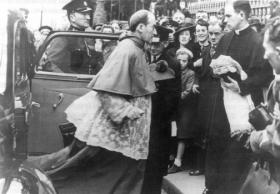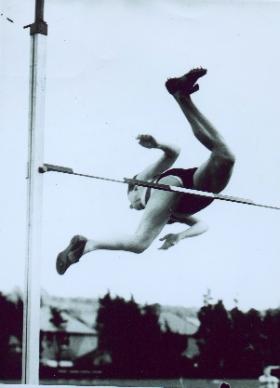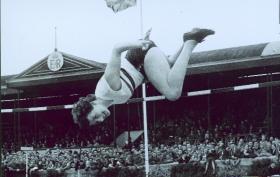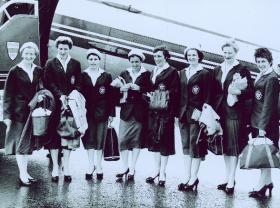Internal tamponage, hockey parturition and mixed athletics
Published in 20th Century Social Perspectives, 20th-century / Contemporary History, Features, Issue 6 (Nov/Dec 2007), Volume 15
John Charles McQuaid, archbishop of Dublin—in April 1944 he wrote to the minister for health ‘concerning the use of internal sanitary tampons, in particular, that called Tampax’. (Multitext Project)
In 1934 the National Athletic and Cycling Association suggested hosting a women’s 100 yards sprint as part of their national championships. The response to this innovation reveals a lot about the position of women in Irish society at that time. Discussion frequently centred on the attire to be worn by sportswomen. Given the restrictions on women’s movements, it is easy to underestimate the sporting spaces that women could inhabit.
Athletics for women had been introduced at the Olympic Games in 1928 after the retirement of the founder of the modern Olympic movement, Baron Pierre de Courbetin, who had very clear views on the place of women in sport. He declared that ‘women have but one task, that of the role of crowning the winner with garlands, as was their role in ancient Greece’. By 1956, the longest women’s race on the programme was 220 yards (200 metres). The 3,000 metres and marathon were only introduced in 1984. The 3,000 metres steeplechase will be introduced in 2008.
‘Un-Irish and un-Catholic’
In Ireland, leading the fray against mixed athletics in 1934 was Revd John Charles McQuaid, then president of Blackrock College, a Catholic boys’ school run by the Holy Ghost Fathers. In a letter to the Irish Press on 24 February 1934, which was also published in The Irish Times the same day, he made it clear that ‘the issue is not: in what forms of athletic sport may women or girls indulge, with safety to their well-being. That question should be duly determined by medical science, rightly so called’. Neither, he argued, was it a question of female activity within their own colleges and associations; that ‘question should be duly solved by the principles both of Christian modesty and of true medical science’. He asserted that ‘mixed athletics and all cognate immodesties are abuses that right-minded people reprobate, wherever and whenever they exist’. To clinch his argument, McQuaid declared: ‘God is not modern; nor is his Law’. Women competing in the same sporting arenas with men were ‘un-Irish and un-Catholic’, and mixed athletics were a ‘social abuse’ and a ‘moral abuse’. He then went on to quote the encyclical letter of Pope Pius XI, Divini Ilius Magistri, which he helpfully translated: ‘in athletic sports and exercises, wherein the Christian modesty

Thelma Hopkins’s world-record high jump at the Cherryvale sports grounds, Queen’s University, Belfast, in May 1956. (Seán and Maeve Kyle)
of girls must be, in a special way, safeguarded, for it is supremely unbecoming that they flaunt themselves and display themselves before the eyes of all’.
In private correspondence, Father John Roe of St Mary’s Christian Brothers school in Dundalk congratulated Dr McQuaid on his ‘splendid protest in the recent athletic proposition. Please God your timely action will prevent the carrying out of the monstrous suggestion.’ To introduce mixed athletics was an ‘unchristian imposition on a Catholic people’, according to Revd Dr Conway, the chaplain at St Mary’s teacher training college for Catholic females in Belfast.
Writing in the Irish Press, J. P. Noonan of St Mary’s, Marino, the Christian Brothers teacher training college, congratulated McQuaid and expressed the hope that the protests would ‘kill the pagan proposal of the athletic association’. Thus a newspaper debate was initiated on women’s opportunities in sport. The GAA waded in. Dr Magnier (Cork) supported the views of McQuaid (without naming him), since ‘people of influence’ asked that women not be allowed to play at Croke Park. Dr Magnier pointed out that from the ‘moral point of view it was absolutely wrong to be running young men and women in the same field in the same garb now effected for these events’. Echoing McQuaid, Mr O’Brien of Clare said that the pope, in a recent encyclical, objected to women taking part in tug-o’-war, ‘wrestling and boxing competitions but he did not object to them taking part in the lighter forms of athletics, such as running and jumping’. Revealingly, he ‘believed that freer mingling of the sexes on the athletic field would do good’. An Ulsterman, Mr O’Reilly, said that in Northern Ireland women had been ‘competing in athletic contests for a long time. Public opinion was so much against it, however, that the GAA in Antrim had to prevent women athletes from appearing in Corrigan Park in anything but gym dresses.’
By March 1934, such was the impact of the controversy that the National Athletic and Cycling Association had decided not to implement mixed athletics, although officially they were still in favour of the idea. James McGilton, the honorary secretary of the NACA, assured McQuaid that his letter to them would be discussed at the next meeting. McGilton also massaged McQuaid’s ego by suggesting that the headmaster’s ‘protest was made in the best interests of the Association’. Furthermore, McQuaid wrote to the Daily Herald and declared that ‘no boy from the college would be permitted to compete at any meeting at which women were to take part’.
The 30-year-old Camogie Association supported McQuaid’s proposal. Seán O’Duffy, the organising secretary, reassured the readers of the Sunday Independent that the association ‘would do all in its power to ensure that no girl would appear on any sports ground in a costume to which any exception could be taken. If they remained Irish in the ordinary acception [sic] of the word they could not go wrong.’ Not everyone shared this view, however. Mr McManus thought that ‘something should be done to support women in this. They are taking part in different kinds of sport all over the world.’ When the NACA decided not to permit mixed athletics, McManus complained about the decision and pointed out that the ‘largest clubs in the city have events for ladies—cycling and all’. This seemed to be a minority view, however. The impact of McQuaid’s complaints spread to the west. The East Galway Democrat explained that ‘on the grounds of delicacy and modesty there is grave objection to women taking part in athletics with men, and women should not be blind to this’.
What did the women think? Miss Dockrell, the women’s 100 yards swimming champion, thought it was ‘hard to understand the ban, since there was no question of “mixed athletics”’. Eileen Bolger was, according to the Irish Press, a well-known Irish runner. She did not see what objection could be taken to girls competing in reserved events. A 100 yards championship for girls was held annually at the civil service sports, and an event for girls was included in the Garda sports competition. J. J. McGilton, secretary of the NACA, supported this development. He told an Irish Press reporter that, until the 1930s, women had competed in reserved events at men’s meetings and no objection was made. The 100 yards championship for women had been in existence for years. After McQuaid’s campaign, however, mixed athletics were not countenanced.

Thelma Hopkins at the 1956 RUC sports day. (Seán and Maeve Kyle)
The moral dangers of Tampax
A decade later McQuaid, by now archbishop of Dublin, was still concerned about the movements of Irish women. In April 1944 he wrote to Dr Conn Ward, parliamentary secretary to the Minister for Local Government and Public Health, and informed him that at the ‘Low Week meetings of the Bishops, I explained very fully the evidence concerning the use of internal sanitary tampons, in particular, that called Tampax. On the medical evidence made available, the bishops very strongly disapproved of the use of these appliances, more particularly in the case of unmarried persons.’ ‘Unmarried persons’ was a euphemism for women. Did men actually use Tampax? Were they seen as a contraceptive device? It requires a remarkable gynaecological imagination to see Tampax as a contraceptive. The more pertinent fear, however, was that women might derive sexual stimulation from Tampax. This reflects the cultural anxieties of the era.
McQuaid’s medical advisor was Dr Stafford Johnson, who had studied in Clongowes Wood College and graduated in medicine from UCD in 1914. He took a particular interest in medico-moral issues and was an enthusiastic advocate for Catholic ethics in medicine. Early in 1944, Stafford Johnson wrote to McQuaid requesting the return of the Catholic Medical Guardian, which he had earlier lent to McQuaid, ‘in which there was given the pronouncement of the English hierarchy on internal tamponage’. With an ill-disguised sinister tone, Stafford Johnson explained that an ‘interesting development has occurred. Tampax has been off the market here for over a year and a half. One of our Knight Chemists [Stafford Johnson was a Supreme Knight of Columbanus] has just rung me up to say it is about to be in stock once more but has not been delivered from the agent.’ The ‘moral dangers’ of Tampax were pointed out to the chemist and the crisis was averted. It was 1944 after all! The obsession with female fertility so concerned the archbishop that certain middle-class Catholic girls’ schools were discouraged from playing hockey since the twisting movements were alleged to cause ‘hockey parturition’, that is, infertility. Hence lacrosse was favoured. The latter activity did not necessitate as much midriff movement. While these students were physically active, it was within the confines of an all-female environment. Schools under the management of the Loreto sisters participated in their own sports event from 1905. The Loreto Shield was introduced specifically for athletics, 23 years before women were allowed to compete at the Olympic Games in athletics. Students at various Sr Louis schools played a variety of games from basketball to camogie.

Thelma Hopkins (second left), Maeve Kyle (third right) and Mary Peters (second right) departing for the 1958 Empire Games, Cardiff. (Seán and Maeve Kyle)
As long as women were not flaunting themselves in front of males, it was possible to pursue sporting activities. The Women’s Amateur Athletic Association (a women-only organisation) was to have a particular impact on the development of athletics for women in Northern Ireland. Furthermore, when the Northern Ireland Amateur Athletic Association appointed Franz Stampf as coach in the 1950s, he worked with Thelma Hopkins, who went on to break the world record (in May 1956) as well as to win an Olympic silver medal (the following December) in the high jump. Hopkins remembered that when she first played hockey for Ireland ‘we had to wear long black stockings and tunics down to our knees. Really, it was extremely difficult to play. But in the North, we had a lot of support from the men, mainly because Stampfl was there and his athletes were taken seriously.’ It may be no accident that Maeve Kyle (née Shankey), who was born in Kilkenny and played hockey for Trinity College and Ireland, did not become involved in athletics until she married an athletics coach, Seán Kyle, and moved to Ballymena, Co. Antrim. In 1956 she became the first Irish woman to compete in athletics for the Republic of Ireland at the Olympic Games.
As late as the 1960s McQuaid was still concerned with ‘unnatural pleasures’ associated with female gymnastics, especially the pommel horse. He was apparently unaware of the unnatural pain associated with the event. Both McQuaid’s and later commentators’ obsession with female activity have blinded many to the varieties of activities in which women could indulge, but the sensual sight of mixed athletics did not become a reality in Ireland until the 1960s.
Margaret Ó hÓgartaigh is based at the Stout Centre, Victoria University of Wellington, New Zealand.
Further reading:
T. McNab, The Olympics (London, 1984).
L. Naughton and J. Waterston, Irish Olympians (Dublin, 1992).
P. O’Hara, The Amazing Kyles (Ballymena, 2007).
















